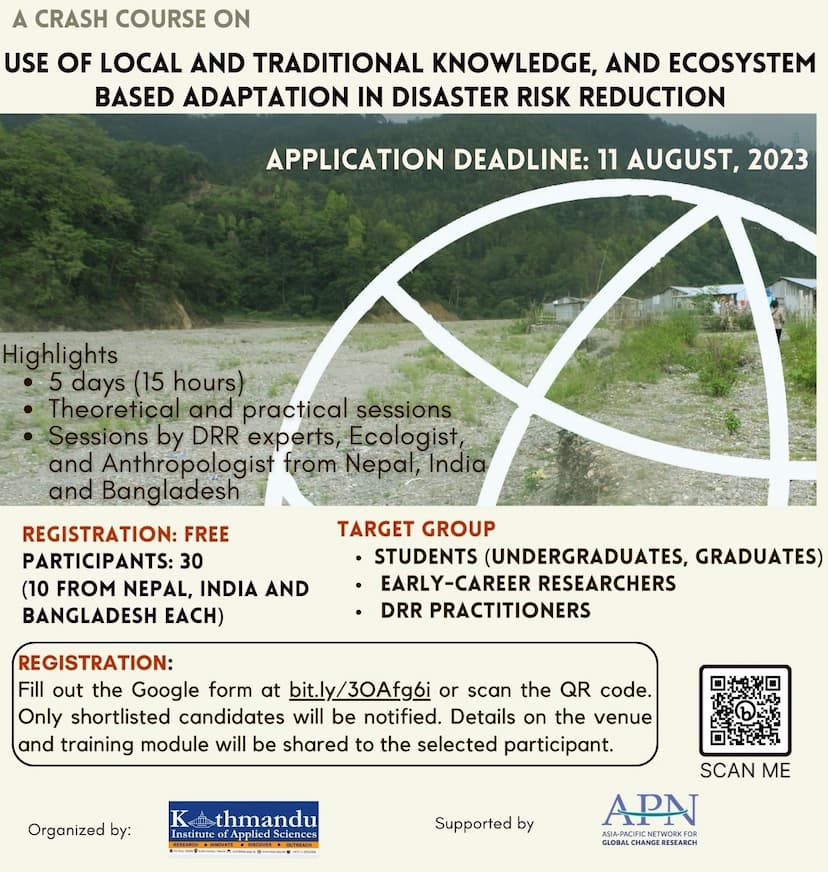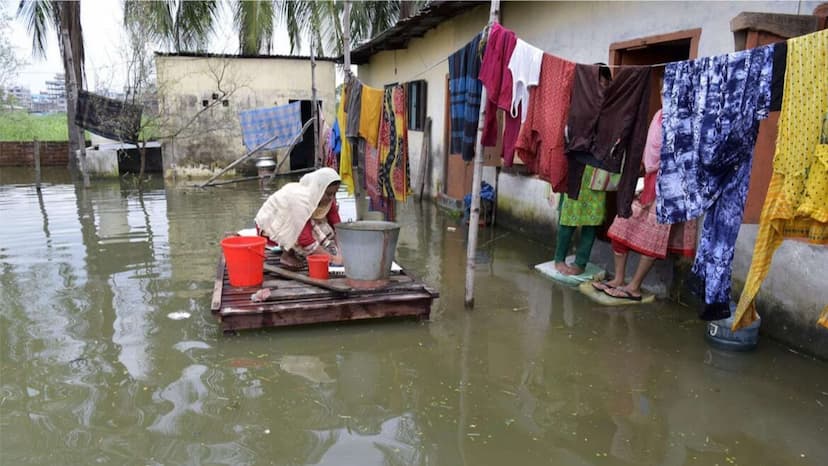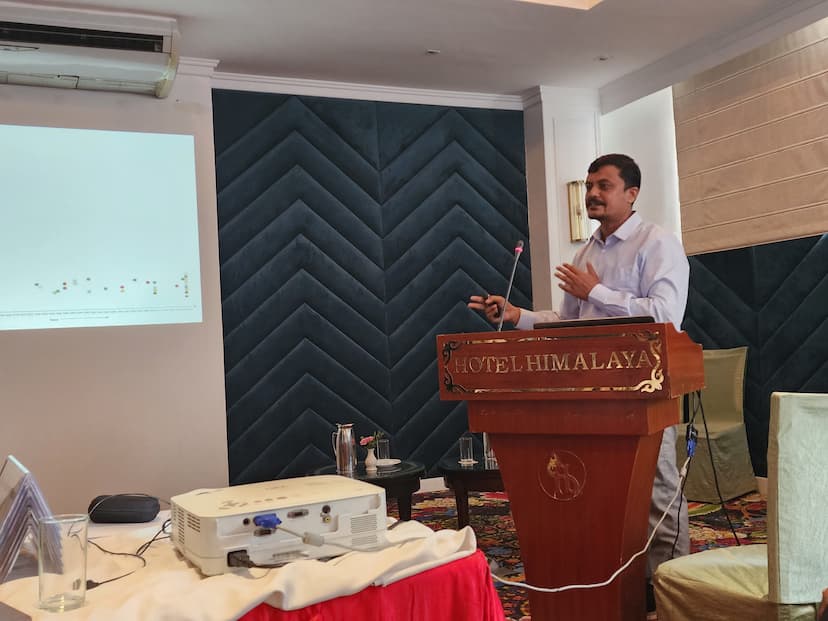Blogs & News

A Crash Course on Use of Local and Traditional Knowledge, and Ecosystem Based Adaptation in Disaster Risk Reduction
## Application Deadline: 11 August, 2023 ## Course Details: **Duration:** 5 days **Target Participants:** 30 selected individuals (10 from Nepal, India, and Bangladesh each) **Audience:** Undergraduates, Graduates, Early-career Researchers, and Disaster Risk Reduction (DRR) Practitioners ## Course Highlights: **Learn from Experienced Experts:** DRR experts, Ecologists, and Anthropologists from Nepal, India, and Bangladesh will share their knowledge and experiences, showcasing the integration of traditional practices and ecosystem-based approaches in enhancing resilience against natural and climate-induced disasters. **Interactive Workshops**: Engage in hands-on workshops that encourage active participation and collaborative learning. Submit your application at bit.ly/3OAfg6i or scan the QR code

Role of organizations in preparedness and emergency response to flood disaster in Bangladesh
In Bangladesh, flood disasters are a common occurrence, affecting millions of people and causing significant damage to infrastructure and property. The country has been proactive in taking measures to mitigate the impact of flood disasters and to provide relief to those affected. Several organizations, both governmental and non-governmental, play a crucial role in preparedness and emergency response to flood disasters in Bangladesh. The Bangladesh Red Crescent Society (BDRCS) is a leading organization in the country that provides emergency response during flood disasters. They have established emergency response teams and trained volunteers who can quickly respond to emergencies, provide first aid, distribute relief items, and help people evacuate to safer areas. The government also plays an important role in disaster preparedness and response. The Department of Disaster Management (DDM) is responsible for coordinating disaster preparedness and response efforts in the country. They work with other government agencies and non-governmental organizations to develop contingency plans, provide early warning systems, and coordinate relief efforts. International organizations like the United Nations Development Programme (UNDP), the International Red Cross, and UNICEF also provide support to Bangladesh in disaster preparedness and response. These organizations provide financial assistance, technical expertise, and other resources to help the government and local organizations prepare for and respond to flood disasters. Non-governmental organizations (NGOs) such as Oxfam, CARE, and Save the Children are also active in Bangladesh, providing assistance to affected communities during floods. They provide relief items such as food, water, and shelter, and also work on longer-term solutions such as disaster risk reduction and community development programs. In conclusion, the role of organizations in preparedness and emergency response to flood disasters in Bangladesh is crucial. Governmental and non-governmental organizations work together to provide relief to those affected, develop contingency plans, and build capacity for disaster risk reduction. Through their collective efforts, they can minimize the impact of floods on the people and infrastructure of Bangladesh. _Picture by: Sk Hasan Ali/Shutterstock_
Field trip to Garaiya and Chiliya Tappu (Locally known as Srilanka Tappu)
On March 31st, 2022, following our breakfast in Chatara, which is located downstream of the Koshi River and serves as a bridge between the Sunsari and Udayapur districts, we took an auto-rickshaw towards Srilanka Tappu. The driver of the rickshaw was a young man with a small mustache and a confident demeanor. During the ride, we inquired about his daily life and livelihood, to which he responded with an optimistic outlook and a sweet smile. Despite the dirt road, we arrived safely to our destination. As we continued our journey, we traveled 7km further from Chatara to reach the villages of Garaiya and Chiliya, which are located on the bank of the Koshi River in the Sunsari district. These villages are known for their unique river triggered challenge, river bank cutting, locally known as Kattan, which involves sliding down the land by the current of the river. As we began our journey, we were greeted by the sight of the meandering Koshi River and the vast expanse of land adorned with rows of quaint, temporal cottage-style houses. The pastoral land nearby was home to a grazing herd of contented cattle, while the cool breeze carried with it tiny particles of sand dust. A straight pathway separated the village from the agricultural land, with an electricity line running alongside it. We spotted a verdant hectare of cultivated land that was irrigated by a water pump. The fields were filled with healthy-looking crops, including maize, wheat, and various vegetables. Upon arriving at the village, we were greeted by Mr. Purnase Rai who was lounging under the shade of a tree, enjoying the cool breeze of the Koshi River while ignoring the oppressive humidity outside. We engaged in a lengthy conversation with him about the impact of floods on his life, despite the fact that he migrated to this area three years ago from the hilly region of Udhyapur in search of a better livelihood. When purchasing his non-registered land, he was well aware of the threat of the Kattan of Koshi. Although the Koshi River was located miles away from his residence, the devastating effects of Kattan were not fully realized until approximately 15-20 years later. In recent years, particularly the last two, there has been extensive Kattan, which is experienced throughout the year, with peaks during the monsoon season and slowly decreases during other seasons. The land structure consists of loose sandy soil, which is why on average approximately one meter of land is eroded by the Koshi River on a daily basis. Mr Purnase Rai explained his experience with the Kattan he says that “बाढी आउन थालेसी हिलो माटो लतत आउछ, हिलो दंग दंग गनाउदै आउंछ” – meaning “the muddy water with bad smell indicates that flood. Emotionally he shares “ढुङ्ग्रोबाट पानी घोपटाय जस्तो गरी पानि पर्छ, भक भक घर जत्रो बलुवा माटो झर्छ, फेरी रेट्छ फेरी झर्छ गर्दै यता आइपुगो, राती बगाउने होकी भनेर निन्द्रै पर्दैन” in this area cloudburst occurs and massive Kattan occurs along with the landslide. Even hard to take nap and life is really tough during the monsoon. To address the issue of Kattan in the Koshi region, a triangular-shaped concert block called Tri-Khutti has been installed in the upper region of Srilanka Tappu, with the cooperation of Nepal and India. Since the implementation of Tri-Khutti, there has been some relief from the effects of Kattan, although it is not considered a permanent solution by the locals. The construction of Tri-Khutti was overseen by both the Nepali and Indian governments. Despite its limitations, the installation of Tri-Khutti has given hope for a better future in the Koshi region. During the conversation, he shared a harrowing experience of how he and his wife had to run for their lives at midnight to escape an elephant attack. They fled from their home to their neighbor's house and were able to survive. However, when he returned the following morning, he found that his house had been destroyed. As he recounted this traumatic incident, tears welled up in his eyes. He expressed his longing for his birthplace and revealed that he planned to return to Udhayapur. However, he was fortunate in a way, as nobody was willing to borrow his land due to the constant threat of Kattan from the Koshi River.
Yatra to Gobargada
On May 23rd, 2022, we made the decision to visit Koshi for the second time, leaving Kathmandu. At approximately 3:30 pm, we arrived in Bhardha and immediately took an auto-rickshaw to Hanuman Nagar, where we planned to travel to Gobaragada, situated in the southern part of the Saptari district, about 7km from the east-west highway. This island-like village in the middle of the Koshi River, near the border of India, presented a transportation challenge as no services were available except for boating. We informed the local police station of our intention to visit Gobargada and contacted the representative of Hanuman Nagar Kankai Municipality-13, Mr. Kusheshwor Yadav, who welcomed us warmly and promised his support. Though he would not be staying in the village, he assured us that he would inform all the villagers to assist and help us. Local markets run every Monday and Thursday in Gobargada, locally known as Hatiya. People from different villages come to sell their local products and buy necessary items. During our visit, we bought a fresh watermelon and relished it. Shortly after, Mr. Yadav introduced us to a villager who offered to accompany the village and provide help if needed. As we began walking, he advised us to change our clothing, remove our shoes and socks, and wear shorts, as we would need to cross several small rivers with water levels up to 4-5 feet. We were surprised as we had been informed that boat services were available for every river, regardless of size. When we asked the man, Mr. Sada, about the boat service, he replied with a smile, "sir, boat service is only available for the big river; we have to cross all the small ones ourselves." We had no other option but to follow his instructions and embark on our journey to Gobargada.

Research Presenatation: EbA Kathmandu Conference III
Raja Ram Chandra Timilsina delivered a presentation titled "Living in Koshi floodplain: Mobile human settlement and reliance on local resources are adaptation strategies to disaster risk reduction" on September 28th, 2022 at the EbA Kathmandu Conference III, organized by the Resources Himalaya Foundation. The presentation focused on the unique adaptation strategies employed by local communities living in disaster-prone areas. These strategies were based on the communities' socio-cultural systems, local context, and environmental resources. One of the key findings shared during the presentation included a detailed examination of how the communities in Sri Lanka Tappu (Gariya Tappu) and Gobargada villages, living along Koshi floodplains are coping with recurrent floods and river channel shifting. The findings revealed that the abundant and productive lands in these areas provided critical livelihood support for the communities, who relied heavily on animal husbandry and agriculture production. Additionally, a swift shift of human settlement in response to the change in the river channel was found to be an effective coping strategy. Almost all of the construction materials of houses and buffalo sheds (98%) in these areas were made of three plant species that were abundant in the surrounding environment. Furthermore, the houses were designed in such a way that they can be disassembled into several pieces, making them easier to transport and assemble in case of need. The study concludes that these unique adaptation strategies are critical for local communities' resilience to disasters, and they should be given full consideration in future disaster risk reduction strategies in similar areas.
Field Visit to Koshi
In March 2022, a team of researchers at Center for Conservation Biology, Kathmandu Institute of Applied Sciences, led by Dr. Prakash K Paudel embarked on a field data collection mission to the Koshi Flood region. The team includes Arjun Lamichhane, RC Timilisina and Durlav Rayamajhi. The purpose of the mission was to collect information regarding traditional knowledge on disaster risk reduction. The team began their survey and discussion from the Bachhi village, where they stayed for a week. The village is located near Triyuga River and is known for its high susceptibility to natural disasters, particularly flooding. The team was overwhelmed by the positive response and hospitality from local communities. The researchers used several approaches to collect both qualitative and quantitative data on disaster risk reduction that have been in practice for several generations in the region. They identified several approaches that will be instrumental in developing effective disaster risk reduction strategies for the region.